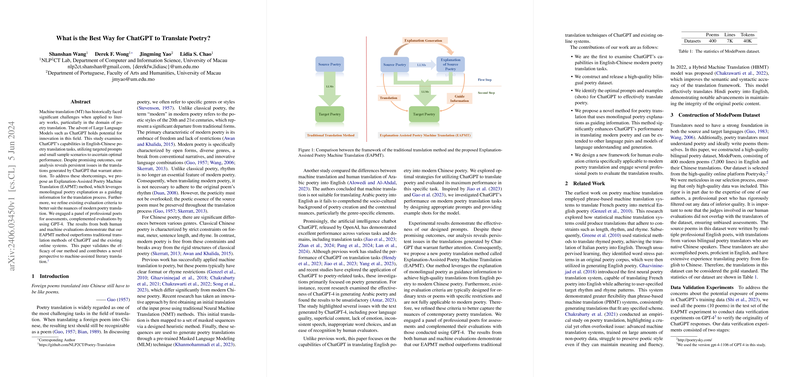Analyzing ChatGPT’s Role in Translating Poetry: Methods and Challenges
The paper "What is the Best Way for ChatGPT to Translate Poetry?" by Wang et al. investigates the application of ChatGPT in the complex domain of poetry translation, particularly from English to modern Chinese. Historically, machine translation (MT) has been inadequate for literary translations due to the nuanced language, cultural references, and stylistic demands such as those found in poetry. The advent of sophisticated LLMs like ChatGPT presents novel opportunities to enhance MT capabilities in this difficult arena.
Key Contributions
The authors target the capabilities of ChatGPT for translating poetry, highlighting persistent translation issues and proposing a new methodology, the Explanation-Assisted Poetry Machine Translation (EAPMT). This research is crucial because it refines evaluation criteria with a focus on modern poetry’s unique characteristics and involves professional poets in evaluation, providing a comprehensive quality analysis.
- Dataset Formulation: The ModePoem dataset was created, encompassing 400 high-quality bilingual poems, facilitating robust experimentation.
- Prompt Optimization: The paper emphasizes prompt engineering as a critical factor in maximizing ChatGPT’s translation effectiveness. Through systematic prompt testing, the authors identified the most suitable prompts for GPT-3.5 and GPT-4.
- Explanation-Assisted Framework: The EAPMT approach incorporates monolingual explanations to guide the translation process, significantly improving the outcomes compared to traditional translation techniques.
Methodology and Experiments
The authors evaluated ChatGPT’s translation proficiency using targeted prompts and conducted few-shot learning experiments to discern optimal configurations. The paper acknowledges the difficulty of translating poetry due to its inherent freedom and structure variability, establishing that zero-shot prompting delivered the best results, contrary to existing narratives in MT literature.
Evaluation and Results
Human Evaluation:
A nuanced, multi-criteria evaluation framework assessed various attributes including overall impression, similarity, fidelity, line-breaking, meaning, poeticity, accuracy, and errors. EAPMT notably outperformed conventional techniques in maintaining line-breaking accuracy and overall poetic quality, underscoring ChatGPT’s potential with the right methodological adjustments.
Automation and the Role of GPT-4:
The research employed GPT-4 for parallel assessments, noting that the refined translations consistently outperformed those of traditional models. This outcome demonstrates the validity of the EAPMT method and aligns with human evaluations, reinforcing the model's enhanced comprehension and poetic replication.
Implications and Future Work
The paper provides a critical lens on the limitations of current MT technologies in handling literary translations and posits that, while improvements are significant, further refinements could enhance fidelity and stylistic accuracy. The ongoing exploration into incorporating human expert involvement, especially in the explanatory phase, promises further advancements.
Future challenges will likely focus on adapting this approach to classical and rhymed poetry and extending methodologies across diverse language pairs and poetic styles. This research marks a step forward in aligning AI capabilities with humanistic tasks, providing a foundation for subsequent studies aimed at bridging the complex interplay between linguistic fidelity and creative expression.
